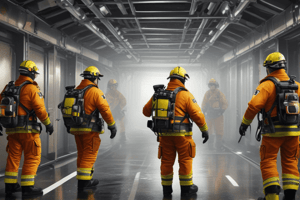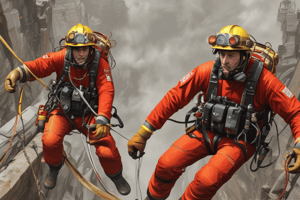Podcast
Questions and Answers
Which operational level provides the minimum capability for fire companies responding to technical search and rescue incidents?
Which operational level provides the minimum capability for fire companies responding to technical search and rescue incidents?
- Expert
- Awareness (correct)
- Technician
- Operations
What is the primary purpose of the guidelines established for technical search and rescue incidents?
What is the primary purpose of the guidelines established for technical search and rescue incidents?
- To enforce strict command protocols
- To provide advanced training to all fire personnel
- To limit rescue attempts for safety
- To assist companies in assessing hazards and defining roles (correct)
Which of the following is NOT a role associated with the Operations level in technical rescue?
Which of the following is NOT a role associated with the Operations level in technical rescue?
- Identifying hazards
- Apply limited techniques
- Using equipment
- Applying advanced rescue techniques (correct)
What is an important consideration for personnel performing rescues as outlined in the guidelines?
What is an important consideration for personnel performing rescues as outlined in the guidelines?
At which operational level can companies use equipment and apply limited techniques as per established guidelines?
At which operational level can companies use equipment and apply limited techniques as per established guidelines?
What is the primary responsibility of technicians responding to technical search and rescue incidents?
What is the primary responsibility of technicians responding to technical search and rescue incidents?
Which document outlines operations and training for technical rescue that rescuers must be familiar with?
Which document outlines operations and training for technical rescue that rescuers must be familiar with?
What key factors should company officers and rescuers assess during a technical rescue incident?
What key factors should company officers and rescuers assess during a technical rescue incident?
During scene assessment, which of the following questions is NOT advised for first arriving officers?
During scene assessment, which of the following questions is NOT advised for first arriving officers?
In the context of technical rescue, what most accurately describes the role of effective scene assessment?
In the context of technical rescue, what most accurately describes the role of effective scene assessment?
What should be done if there are language barriers between witnesses and rescuers?
What should be done if there are language barriers between witnesses and rescuers?
Under which condition should operations be conducted as a rescue rather than a body recovery?
Under which condition should operations be conducted as a rescue rather than a body recovery?
What is the first step when determining the mode of operation in a rescue scenario?
What is the first step when determining the mode of operation in a rescue scenario?
If victims are not expected to survive, what type of operation should be conducted?
If victims are not expected to survive, what type of operation should be conducted?
Which scenario would NOT require the activation of the TFD Rescue Task Force?
Which scenario would NOT require the activation of the TFD Rescue Task Force?
What is a critical factor for establishing the command structure in response to an incident?
What is a critical factor for establishing the command structure in response to an incident?
Which of the following incidents would not fall under the TFD Rescue Task Force's responsibilities?
Which of the following incidents would not fall under the TFD Rescue Task Force's responsibilities?
In a confined space rescue, which aspect is most crucial for the incident commander to consider?
In a confined space rescue, which aspect is most crucial for the incident commander to consider?
Which type of emergency would NOT typically involve TFD Rescue Task Force efforts?
Which type of emergency would NOT typically involve TFD Rescue Task Force efforts?
The IC should call for a bilingual individual to assist with communications if there is a language barrier
The IC should call for a bilingual individual to assist with communications if there is a language barrier
NFPA ____ standard on operations and training for technical search and rescue incidents
NFPA ____ standard on operations and training for technical search and rescue incidents
Scope: the following guidelines shall ___ and ____ levels of ____ capability for fire companies conducting operations at technical search and rescue incidents
Scope: the following guidelines shall ___ and ____ levels of ____ capability for fire companies conducting operations at technical search and rescue incidents
purpose: the purpose of this section shall be to assist companies and commanding officers in ____ technical search and rescue hazards, define the ___ and _____ of fire companies at tech search and rescue and establish command ____ for ops at technical search and rescue incidents
purpose: the purpose of this section shall be to assist companies and commanding officers in ____ technical search and rescue hazards, define the ___ and _____ of fire companies at tech search and rescue and establish command ____ for ops at technical search and rescue incidents
Flashcards
Technical Rescue Response Guidelines
Technical Rescue Response Guidelines
Guidelines for fire department capabilities during technical search and rescue incidents, emphasizing personnel safety and outlining roles and command structure.
Goals of Technical Rescue Response Guidelines
Goals of Technical Rescue Response Guidelines
Aimed at assisting in hazard assessment, determining roles, and establishing an organized command structure for technical rescue incidents.
Awareness Operational Level
Awareness Operational Level
Specifies the minimum capabilities for fire companies responding to technical rescues, including basic awareness of hazards and procedures.
Operations Operational Level
Operations Operational Level
Involves identifying hazards, using basic equipment, and applying limited techniques to support technician-level resources during technical rescues.
Signup and view all the flashcards
Technician Operational Level
Technician Operational Level
Represents the highest level of capability in responding to technical rescue incidents, involving specialized skills, equipment, and supervision.
Signup and view all the flashcards
Importance of Organized Operations in Technical Rescue
Importance of Organized Operations in Technical Rescue
Organized operations are crucial in technical rescue due to high-risk scenarios, minimizing casualties during complex situations.
Signup and view all the flashcards
Key Elements for Successful Rescue Operations
Key Elements for Successful Rescue Operations
Assessing personnel and equipment capabilities, evaluating the scene, and establishing a well-defined command structure.
Signup and view all the flashcards
Initial Scene Assessment by First-Arriving Officers
Initial Scene Assessment by First-Arriving Officers
Gather information about the incident's nature, victim status, stability of the situation, and potential hazards.
Signup and view all the flashcards
When to Deploy TFD Rescue Task Force
When to Deploy TFD Rescue Task Force
Deployment of the TFD Rescue Task Force is warranted when incident requirements exceed available on-scene resources.
Signup and view all the flashcards
Examples of Incidents Requiring Advanced Technical Rescue Resources
Examples of Incidents Requiring Advanced Technical Rescue Resources
Collapsed structures, stranded or trapped victims in confined spaces, trenches, water, elevators, or vehicles.
Signup and view all the flashcards
Command Structure in Technical Rescue
Command Structure in Technical Rescue
Incident Commanders must establish a clear and adaptable command structure to manage technical rescue operations effectively.
Signup and view all the flashcards
Communication Challenges in Technical Rescue
Communication Challenges in Technical Rescue
Language barriers can hinder communication; ICs should seek bilingual support when necessary.
Signup and view all the flashcards
Operational Modes in Technical Rescue
Operational Modes in Technical Rescue
Determining operational mode based on victim viability, either conducting rescue operations or transitioning to body recovery efforts.
Signup and view all the flashcards
Rescue Operations
Rescue Operations
Conducting rescue operations with the primary aim of rescuing viable victims.
Signup and view all the flashcards
Body Recovery Operations
Body Recovery Operations
Shifting to body recovery operations when victims are deemed non-survivable.
Signup and view all the flashcards
Command Structure: Crucial for Success
Command Structure: Crucial for Success
The importance of establishing a well-defined command structure ensures organized and efficient operations during technical rescues.
Signup and view all the flashcards
Key Responsibilities of Technical Rescue Teams
Key Responsibilities of Technical Rescue Teams
Assessing and managing hazards, coordinating resources, and executing rescue techniques safely during technical incidents.
Signup and view all the flashcards
Why Technician Level Resources are Important
Why Technician Level Resources are Important
Advanced capabilities are vital for coordinating specialized equipment, deploying specialized techniques, and supervising multiple rescue efforts in complex scenarios.
Signup and view all the flashcards
Scene Assessment: The First Step
Scene Assessment: The First Step
The initial scene assessment is crucial for understanding the incident's details, determining the extent of danger, and guiding immediate response strategies.
Signup and view all the flashcardsStudy Notes
Technical Rescue Response Overview
- Guidelines establish functional capability levels for fire companies during technical search and rescue incidents.
- Aimed at assisting in hazard assessment, defining roles, and establishing a command structure.
- Emphasizes that rescue attempts are permissible as long as personnel safety is not compromised.
Operational Levels
- Three operational levels defined: Awareness, Operations, Technician.
Awareness
- Represents the minimum capability for companies responding to technical search and rescue incidents.
Operations
- Capabilities include identifying hazards, using equipment, and applying limited techniques.
- Supports technician-level resources in technical rescue scenarios.
Technician
- Represents advanced capability in responding to incidents.
- Involves identifying hazards, using specialized equipment, and applying advanced techniques for coordination, performance, and supervision.
Incident Management
- Importance of organized operations due to risks associated with technical rescues.
- Emphasizes knowledge of personnel and equipment capabilities, scene assessment, and command structure to improve outcomes.
Scene Assessment
- First-arriving officers should gather critical information regarding:
- Nature of the incident.
- Number and condition of victims.
- Stability and progression of the situation.
- Hazards and safety issues involved.
Technician Level Resources
- TFD Rescue Task Force deployment is warranted when incident requirements exceed available on-scene resources.
- Examples of incidents requiring advanced resources:
- Collapsed structures.
- Stranded or trapped victims in various locations or conditions (e.g., confined spaces, trenches).
- Victims in challenging environments (e.g., water, elevators, vehicles).
Command Structure
- Incident Commanders (ICs) must establish an appropriate command structure for technical rescue operations.
- Command structures should be adaptable to meet operational needs.
General Considerations
- Language barriers may impede communication; the IC should seek bilingual assistance when necessary.
- Determine the operational mode based on victim viability:
- Conduct rescue operations for viable victims.
- Transition to body recovery operations if victims are deemed non-survivable.
Studying That Suits You
Use AI to generate personalized quizzes and flashcards to suit your learning preferences.




